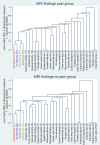MRI evaluation of shoulder pathologies in wheelchair users with spinal cord injury and the relation to shoulder pain
- PMID: 33617411
- PMCID: PMC9661987
- DOI: 10.1080/10790268.2021.1881238
MRI evaluation of shoulder pathologies in wheelchair users with spinal cord injury and the relation to shoulder pain
Abstract
Objective: To describe the number, specifics and co-occurrence of shoulder pathologies detected by MRI in manual wheelchair users with spinal cord injury and to evaluate the association between shoulder pathologies and presence of shoulder pain.
Design: Cross-sectional observation study.
Setting: Community.
Participants: Fifty-one wheelchair-dependent persons with spinal cord injury (44 males, 7 females, median age 50 years (IQR 14), median time since injury 24 years (IQR 16)) were allocated to pain or no-pain group based on the Wheelchair User Shoulder Pain Index.
Interventions: Not applicable.
Outcome measures: All persons underwent shoulder MRI. Pathologies were scored blinded by two experienced radiologists. Participant characteristics, number and severity of shoulder pathologies were analyzed descriptively. Logistic regression was performed to evaluate the association between MRI findings and shoulder pain.
Results: The median number of co-occurring MRI findings per person ranged from 0 to 19 (out of 31 possible findings). The cluster of MRI findings occurring most often together were tendon tears of supraspinatus (present in 84%), subscapularis (69%) and biceps (67%) and osteoarthritis of acromioclavicular joint (80%). When correcting for age and time since injury, the logistic regression showed no statistically significant correlation between the individual pathologies and shoulder pain.
Conclusion: MRI findings of shoulder pathology are very frequent in persons with and without shoulder pain. Therefore, when diagnosing the cause of shoulder pain and planning interventions, health care professionals should keep this finding in mind and MRI should not be interpreted without careful consideration of clinical history and functional testing.
Keywords: Rotator cuff tear; Shoulder pain; Shoulder pathology.
Conflict of interest statement
No potential conflict of interest was reported by the author(s).
Figures



Similar articles
-
Progression of rotator cuff tendon pathology in manual wheelchair users with spinal cord injury: A 1-year longitudinal study.J Spinal Cord Med. 2023 May;46(3):466-476. doi: 10.1080/10790268.2022.2057720. Epub 2022 Apr 14. J Spinal Cord Med. 2023. PMID: 35420535 Free PMC article.
-
Shoulder magnetic resonance imaging findings in manual wheelchair users with spinal cord injury.J Spinal Cord Med. 2022 Jul;45(4):564-574. doi: 10.1080/10790268.2020.1834774. Epub 2020 Nov 9. J Spinal Cord Med. 2022. PMID: 33166207 Free PMC article.
-
Ultrasonographic Measures of the Acromiohumeral Distance and Supraspinatus Tendon Thickness in Manual Wheelchair Users With Spinal Cord Injury.Arch Phys Med Rehabil. 2017 Mar;98(3):517-524. doi: 10.1016/j.apmr.2016.06.018. Epub 2016 Jul 16. Arch Phys Med Rehabil. 2017. PMID: 27431359
-
Effectiveness of Exercise Programs for Management of Shoulder Pain in Manual Wheelchair Users With Spinal Cord Injury.J Neurol Phys Ther. 2015 Oct;39(4):197-203. doi: 10.1097/NPT.0000000000000103. J Neurol Phys Ther. 2015. PMID: 26308939 Review.
-
Upper Extremity Overuse Injuries and Obesity After Spinal Cord Injury.Top Spinal Cord Inj Rehabil. 2021;27(1):68-74. doi: 10.46292/sci20-00061. Top Spinal Cord Inj Rehabil. 2021. PMID: 33814884 Free PMC article. Review.
Cited by
-
Perioperative complications and outcomes in patients with paraplegia undergoing rotator cuff repair.Shoulder Elbow. 2023 Nov;15(4 Suppl):3-14. doi: 10.1177/17585732211036461. Epub 2021 Aug 10. Shoulder Elbow. 2023. PMID: 37974609 Free PMC article.
-
Handrim kinetics and quantitative ultrasound parameters for assessment of subacromial impingement in wheelchair users with pediatric-onset spinal cord injury.Gait Posture. 2024 Sep;113:561-569. doi: 10.1016/j.gaitpost.2024.08.075. Epub 2024 Aug 15. Gait Posture. 2024. PMID: 39182433
-
Increased risk of osteoarthritis in persons with spinal cord injury: a population-based longitudinal follow-up study in Taiwan.Spinal Cord. 2025 Aug 9. doi: 10.1038/s41393-025-01112-x. Online ahead of print. Spinal Cord. 2025. PMID: 40783463
-
Classification of Wheelchair Related Shoulder Loading Activities from Wearable Sensor Data: A Machine Learning Approach.Sensors (Basel). 2022 Sep 29;22(19):7404. doi: 10.3390/s22197404. Sensors (Basel). 2022. PMID: 36236503 Free PMC article.
-
Progression of rotator cuff tendon pathology in manual wheelchair users with spinal cord injury: A 1-year longitudinal study.J Spinal Cord Med. 2023 May;46(3):466-476. doi: 10.1080/10790268.2022.2057720. Epub 2022 Apr 14. J Spinal Cord Med. 2023. PMID: 35420535 Free PMC article.
References
-
- Turner JA, Cardenas DD, Warms CA, McClellan CB.. Chronic pain associated with spinal cord injuries: a community survey. Arch Phys Med Rehabil. 2001;82(4):501–9. - PubMed
-
- Bossuyt FM, Arnet U, Brinkhof MWG, Eriks-Hoogland I, Lay V, Muller R, et al. . . Shoulder pain in the Swiss spinal cord injury community: prevalence and associated factors. Disabil Rehabil. 2018;40(7):798–805. - PubMed
-
- Jensen MP, Hoffman AJ, Cardenas DD.. Chronic pain in individuals with spinal cord injury: a survey and longitudinal study. Spinal Cord. 2005;43(12):704–12. - PubMed
Publication types
MeSH terms
LinkOut - more resources
Full Text Sources
Other Literature Sources
Medical
